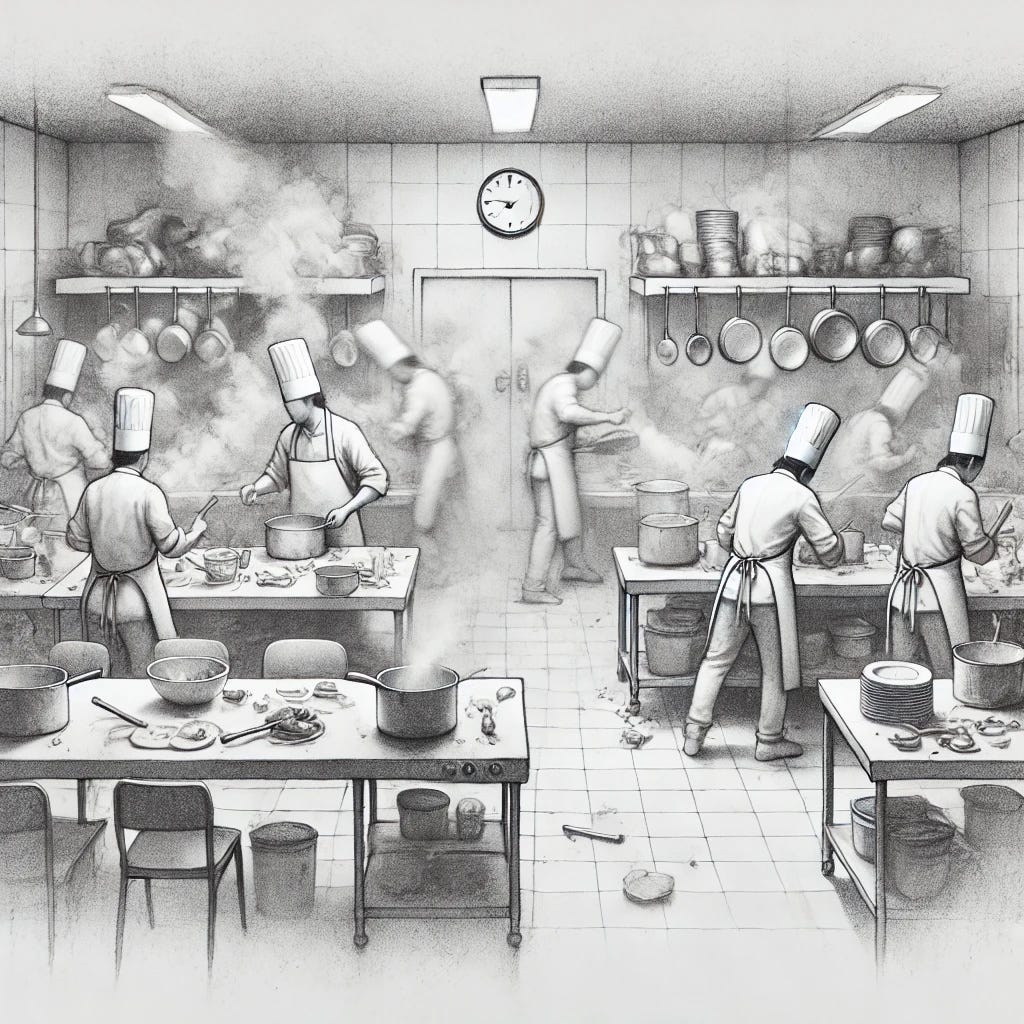Scrum’s Definition of Done Is Polishing Plates in a Burning Kitchen
Imagine a kitchen in chaos. Orders are shouted, chefs scramble to grab random tasks, and no one has time to stop or plan. Amid this whirlwind, the maître d’ stands at the door with a clipboard, refusing to let any dish go out unless it meets an impossible checklist of perfection. It doesn’t matter that the stove is broken or the knives are dull—the dishes must be flawless.
This is Scrum’s Definition of Done in a nutshell: instead of addressing the chaos of the process, it places all responsibility for quality on the developers. Rather than fixing systemic issues like unrealistic deadlines or poor collaboration, the Definition of Done simply demands that teams deliver perfection, no matter the odds.
The Ideal vs. Reality
The Definition of Done bills itself as a tool for good—an agreement among the team to ensure consistent, high-quality work. It’s a checklist of “best practices”: code must be tested, reviewed, documented, and meet all acceptance criteria before it’s shipped.
In theory, this sounds reasonable. But in reality, the Definition of Done doesn’t fix the broken kitchen—it just adds pressure. Scrum’s relentless sprints, rushed planning, and chaotic workflows create an environment where perfection is impossible. The DoD isn’t solving these problems; it’s just pretending they don’t exist.
Ultimately, the DoD is merely a get-out-of-jail-free card. When someone questions why the team is producing subpar work, the Scrum Master can deflect: “Well, there’s a DoD in place. Nothing should be submitted that doesn’t meet that definition.” The implication? Nothing is wrong with the holy process—of course not. The fault must lie elsewhere.1
The Real Problems
The Definition of Done exists because Scrum’s process encourages speed over quality. Here are some of the systemic flaws it tries to mask:
Unrelenting sprints: Scrum’s endless, back-to-back sprints leave no time to pause, reflect, or improve. Developers are forced to rush, cutting corners to meet arbitrary deadlines.
Product manager power imbalances: Product managers prioritize features and velocity over sustainable quality, leaving developers with no say in how the work gets done.
Daily check-ins: These meetings devolve into status reports, eating up time that could be spent solving real problems. Worse, they add stress by putting developers under a magnifying glass, forcing them to constantly justify their productivity. This focus on performative progress shifts attention away from creating real quality, leaving developers pressured to prioritize speed over craftsmanship.
Obsession with estimation: Teams are forced to predict how long tasks will take—guesses that often lead to unrealistic expectations. It’s like estimating how long it’ll take to bake a cake when the recipe hasn’t been written yet.
After all this chaos, the Definition of Done swoops in and demands a perfect result. It’s like telling a stressed-out chef, “The stove is broken? We’ll talk about that in the retro and see what we can do. But how is that cake coming along? It better be perfect, or it’s not going out!”
Why It Falls Short
The Definition of Done doesn’t solve these problems. Instead, it shifts the burden onto developers, forcing them to work harder to meet quality standards that the process itself undermines.
The maître d’ with the checklist may feel like a solution, but in practice, it creates more stress. Developers scramble to test, review, and document at the last minute, trying to meet the DoD’s demands while still sprinting toward the next deadline.
Rather than fostering a culture of quality, the DoD often turns quality into a performance—a box to check off rather than an outcome to achieve. Meanwhile, the chaotic kitchen remains untouched.
What Could Be Better
What if we stopped relying on the Definition of Done as a band-aid and fixed the process instead?
Adjust sprint structures: Build in time for reflection, refinement, and quality improvements.
Empower developers: Shift decision-making closer to the team, allowing developers to focus on quality from the start.
Ditch estimation obsession: Focus on delivering value rather than trying to predict the unpredictable.
Simplify the workflow: Reduce unnecessary meetings and distractions to give teams the time they need to do great work.
By addressing these root causes, we wouldn’t need a maître d’ standing at the door with a checklist. Quality would be baked into the process—not demanded as an afterthought.
Conclusion
Scrum’s Definition of Done is like polishing plates in a burning kitchen. It shifts attention away from the real problems and places an unfair burden on developers to deliver perfection despite a flawed process.
If we want truly great work—whether it’s gourmet dishes or high-quality software—we need to stop relying on checklists and fix the system itself. Let’s focus on collaboration, sustainable pacing, and empowering teams to deliver quality naturally. It’s time to put out the fire and let the chefs (and developers) do their best work.
"To be clear, this isn’t the Scrum Master’s fault. They’re simply following what the process and training dictate. I feel for them—stuck defending a system that puts them in this position. One day, I hope that Scrum Masters everywhere rise up and challenge this useless dogma."




As Scrum Masters, our role is to coach, not dictate. It is the team's responsibility to define the Definition of Done (DoD)—determining the essential criteria that classify a piece of work as "finished."
If the team feels the DoD isn't effective, retrospectives provide the opportunity to refine it. By continuously inspecting and adapting our processes, we ensure the team operates efficiently.
The DoD should be agreed upon by the team, in line with the principle of empowering developers, rather than being imposed by the Scrum Master or external influences. This approach minimizes unnecessary stress, as the team retains ownership and control over the process.